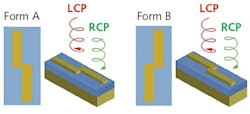Near-infrared metasurface reflects only one direction of circularly polarized light
Chiral surfaces, which have differing responses for left- and right-handed circularly polarized (LCP and RCP) light, can be useful in optical experimentation. Metamaterials, which can be made into circular polarizers, are promising for creating chiral surfaces. Scientists at the Missouri University of Science and Technology (Rolla, MO) and the Argonne National Laboratory (Argonne, IL) have now created a chiral metamaterial-absorbing surface that has a large circular dichroism (CD) over the 1.3–1.8 μm spectral region. The chiral absorber could be useful for optical filters, thermal energy harvesting, optical communication, and chiral imaging.
The metasurface absorber is made of a three-layer thin-film metal-dielectric-metal (55 nm gold, 130 nm silica, and 200 nm gold) structure deposited on a glass substrate and patterned into 2D periodic arrays of identical zig-zag shapes. Five arrays with different sets of dimensions were constructed, each having a different resonance wavelength. The researchers measured their optical reflection spectra with a Fourier transform infrared spectrometer connected to an infrared microscope, using a polarizing setup to specify the polarization of the incoming light. The measured maximum chiral absorption can reach 0.87 while the maximum CD is around 0.70. Reference: L. Ouyang et al., Opt. Express (2018); https://doi.org/10.1364/oe.26.031484.
About the Author
John Wallace
Senior Technical Editor (1998-2022)
John Wallace was with Laser Focus World for nearly 25 years, retiring in late June 2022. He obtained a bachelor's degree in mechanical engineering and physics at Rutgers University and a master's in optical engineering at the University of Rochester. Before becoming an editor, John worked as an engineer at RCA, Exxon, Eastman Kodak, and GCA Corporation.

